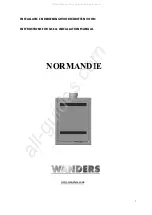
20
Fine-Tuning
The recommended settings found in the vent charts on pages 10 & 11 and the default primary air settings have been
optimized based on extensive testing, however, additional adjustments may be required to accommodate specific in-
stallation circumstances. For example, a north wall installation may require slightly different settings than a south
wall.
Fine-tuning can be accomplished with the stove installed and operating. Please take care not to burn yourself on any
of the hot surfaces. Always wear gloves and other protective equipment.
The stove front and louver should still be removed at this point allowing the two adjuster mechanisms to be accessed.
The settings for each can be adjusted from the recommended settings while you are watching the fire in the stove.
It is important that the fine-tune adjustments are made only after the stove is thoroughly heated so allow the stove to
burn for at least 20-30 minutes at high fire while observing the flame.
The type of adjustments that you might try are somewhat dependent on the type of fuel that is being used. When
burning natural gas, flames that are too short or too blue will be the most common observation. When burning pro-
pane, flames that are too long and too sooty will be most common. Each situation requires different actions.
If you are burning natural gas and observe that the flames are short and blue:
First, check the position of the
primary burner air adjuster
. The adjuster screw is located on the bottom of the fire-
box near the valve. For natural gas, the primary air adjuster should be in the fully-closed position. If it is not, loosen
the adjuster screw locknut and turn the adjuster screw in until it stops. If the appearance of the fire does not change,
you may need to adjust the
air inlet restrictor
. Be careful as the stove surfaces are HOT!
Loosen the air inlet restrictor indicator plate locking wingnut and move the setting up in ¼ increments. For example,
move the setting from 2 ¾ to 3. Tighten the locking wingnut and observe the flames. Repeat the process until the
flames become taller and more luminescent. However, no more than one full increment of adjustment should be
made. If the flames are still too short and blue, next adjust the
exhaust baffle
setting.
Loosen the exhaust baffle indicator plate locking wingnut and move the setting up in ¼ increments. For example,
move from a setting of D to a setting of D ¼. Repeat the process until the flames become taller and more lumines-
cent. However, no more than one full increment of adjustment should be made. If no change in the flame appearance
is noted after that, there may be an installation problem. Consult with a RAIS representative.
If you are burning propane and observe that the flames are tall and sooty:
First, check the position of the
primary burner air adjuster.
For propane, the primary air adjuster should be in the
fully-open position. If it is not, loosen the adjuster screw locknut and back out the adjuster screw until it stops.
If the appearance of the flame does not change, you may need to adjust the
exhaust baffle
. This can be done with the
stove operating but again, be careful as the stove surfaces are HOT!
Loosen the exhaust baffle indicator plate locking wingnut and move the setting down by ¼ increments. For example,
move from a setting of E ½ to a setting of E ¼. Tighten the locking wingnut and observe the flames. Repeat the proc-
ess until flame tips shorten and become lighter in color. However, no more than one full increment of adjustment
should be made. If the flames are still too tall and sooty, next adjust the
air inlet restrictor
setting.
Loosen the air inlet restrictor indicator plate locking wingnut and move the setting down in ¼ increments. For exam-
ple, move the setting from 2 ¾ to 2 ½. Tighten the locking wingnut and observe the flames. Repeat the process until
the flames become shorter and more lighter. However, no more than one full increment of adjustment should be
made. If no change in the flame appearance is noted after that, there may be an installation problem. Consult with a
RAIS representative.
Once all adjustments are made, make sure the air inlet and exhaust baffle adjuster plate locking wingnuts are tight.
If an adjustment was made to the primary burner air, tighten the locknut on the adjustment screw to lock in the new
setting. Shut off the stove and let it cool down.
Reinstall the Louver
Replace the air louver by aligning the slots on the louver end plates with the louver pins on the stove sides. You may
need to lift the top slightly to get “up-and-over” the pins. The louver will drop into place when in the proper position.
Tighten the four decorative top fasteners.
Reinstall the Stove Front
To reinstall the stove front, align the four attachment slots on the door edges with the pins on the stove sides. Push the
front in and down to its final position.
FINE-TUNING









































